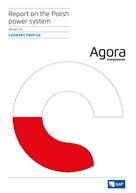Poland stands at the crossroads of important decisions on its energy system. At this juncture, the Polish power mix is still dominated by hard coal and lignite. However, between 2020 and 2035, about 60 power plants constructed in the 1970s are expected to retire. This accounts for more than 50 percent of currently installed capacity. It presents a major modernisation and investment challenge that is discussed against the backdrop of concerns about energy supply security, clean air – particularly in cities –, climate change, rapidly declining costs for renewable energy, and the expected growth of electricity demand.
A new Polish energy strategy is expected by the end of 2018. Some particularly interesting statements in the public debate on this strategy are the announcement by Energy Minister, Krzysztof Tchorzewski, in September 2017, that the Ostrołęka coal-fired power plant would be the last big coal investment in Poland. Also, the announcement by Poland’s largest utility (PGE SA) to develop offshore wind resources in the Baltic Sea is pathbreaking. Clearly, Poland’s new energy strategy will also reflect energy security, foreign policy, and employment considerations in addition to concerns about costs, clean air or climate change.
The progressive integration of wholesale power markets and the growing level of interconnection of electricity systems in Europe also means that energy policy choices in Poland have implications for its neighbours and vice-versa. In this context, the Polish-German relationship is a special one. Both countries face similar challenges regarding the need to reduce carbon dioxide emissions from coal-fired power plants and the socio-economic changes linked to reducing the use of coal-related mining activities.
Furthermore, substantial amounts of unscheduled electricity flows from Germany to Austria over the polish grid have led to significant controversy between the two countries. The introduction of phase shifters on the German-Polish border and the upcoming split of the German-Austrian common bidding zone will – at least partly – mitigate this problem. However, further and intensified cooperation between the two countries remains important to avoid misperceptions, to broaden mutual understanding of domestic energy-policy choices, as well as to identify areas of common interest and opportunities for cooperation.
This updated country profile Poland provides a snapshot of the Polish Power Systems as it stands today. We present the country profile at a time when the domestic energy policy debate in Poland is in full swing, to allow for a better understanding of what is going on. The profile focusses on the main elements of the Polish power system. It is certainly not exhaustive and due to the rapidly changing energy landscape in Poland some parts may quickly be outdated.







